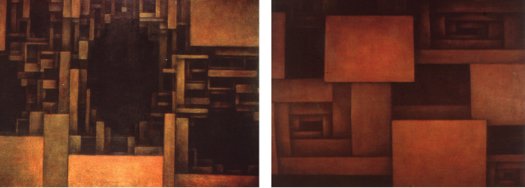vertical line, thus giving the impression that space itself has escaped toward the infinite. The other characteristic, particularly noticeable in portraits, is the predominance of a mask over that intimate and secret interiority sought by classists such as Leonardo Da Vinci. In the portraits by Il Bronzino, for example, the characters are painted almost with the same perfection as Leonardo displays (unlike the coarseness of most of El Greco's figures) and yet Il Bronzino's personae are cold, rigid, closed figures that therefore do not let one get to know them or recognize them in the portrait.
One always finds in mannerism a willful, forced, arbitrary element. This style is the opposite of getting carried away by contemplating nature in an attempt of imitating it, or by an emotion, be this profane or sacred. What other characteristics does mannerist art have? There are at least two. The first is related to the fact that in mannerist paintings, with exception of the portraits of individual persons, the figures are interlinked in a complex nexus of relationships with other figures, as is clearly observed in Michelangelo's "Final Judgement" and in almost all paintings by El Greco. In all these great artistic expressions, the figures, intertwined with one another, ascend in a vertical line, thus giving the impression that space itself has escaped toward the infinite.24 The other characteristic, particularly noticeable in portraits, is the predominance of a mask over that intimate and secret interiority sought by classists such as Leonardo Da Vinci. In the portraits by Il Bronzino, for example, the characters are painted almost with the same perfection as Leonardo displays (unlike the coarseness of most of El Greco's figures) and yet Il Bronzino's personae are cold, rigid, closed figures that therefore do not let one get to know them or recognize them in the portrait.
24 Jvallmitja - Own work, CC BY-SA 4.0, https://commons.wikimedia.org/w/index.php?curid=84727123.
The relationship between mannerism and labyrinth is very simple. The labyrinth is one of the elements most used by mannerist artists, almost as much as the mirror or the monstrosities. One of the first artists to use the idea of the labyrinth, although not being a mannerist himself, was Leonardo da Vinci. He used it, for example, in his coded writing and pictograms, but also later in his abstract games with labyrinthine constructions which, at that time, gave him fame as being a magician. Labyrinthine drawings are almost as ancient as humanity. One can find them in the Stone Age, in Classical Antiquity, in medieval cathedrals (as model of the redemption path leading to celestial Jerusalem), or in the well-known Hindu mandalas. However, with Leonardo the use of this symbol brings about a change: the labyrinthine entwining becomes a model for mystery. Without providing a reference, Gustav René Hocke argues that according to Dante Alighieri
the mystery, God, would have to be symbolized by nodi strani, by strange knots, we may well say by interwoven, objectless lines, by abstract, inextricable figurations.25
In the sixteenth and seventeenth centuries the labyrinthine motif experiences an explosive rise. Labyrinthine gardens became
25 Gustav René Hocke, Die Welt als Labyrinth: Manierismus in der europäischen Kunst und Literatur, Reinbeck, DE: Rowohlt 1987, p. 127, transl. Existenz editors.


Figure 12: Battista Piranesi, labyrinthine prisons: "The Drawbridge" (etching, 1761) 54.5 x 40.7 cm.27
Figure 13: Eduardo Meissner, from the series Labyrinths: "Piranesiana I" (oil on canvas, 1969) 170 x 300 cm (left); "Precolombino II" (oil on canvas, 1968) 150 x 180 cm (right).28

